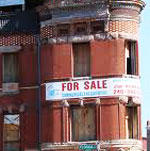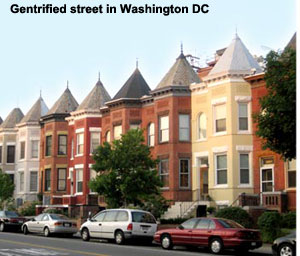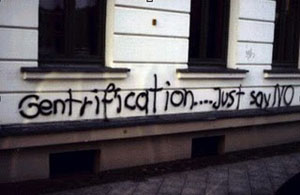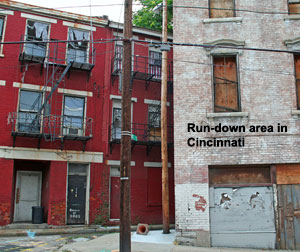
Washington DC residential building to be sold for re-development (Photo: Seth Gaines)

FRONT PAGE
Site Search
About us



Obsolete urban infrastructure
Gentrification of US cities
Revitalizing US cities
Rightsizing US cities
Key to rightsizing cities
America's megaregions
USA Census 2010
USA: Demolition as planning tool
Urban energy saving (USA)
USA: Livable communities
US infrastructure problems
US affordable housing crisis
Urban sprawl - USA
US built environment in 2030
Urban traffic in the US

Worldwide | Elections | North America | Latin America | Europe | Asia | Africa |


























Gentrification poses a new
dilemma for many US cities
By City Mayors’ Special North America Correspondent
29 September 2011: Gentrification has been a characteristic of major American cities like New York and Boston for over a century, but in the past decade it has become part of the growth cycle of smaller cities as well. Minority and working class neighborhoods such as Pittsburgh’s South Side; Northwest Fort Lauderdale, Florida; and East Austin, Texas are being transformed as white and middle-class residents move in.
 In the United States, central urban neighborhoods — close to theaters, museums, restaurants, and downtown offices — are typically home to the poor, minorities, immigrants, and elderly. But demographic change has led to an increase in one- and two-person families, and this has made proximity to cultural and entertainment venues a desirable feature in real estate markets. Baby boomers — those born during the huge birth rate increase that accompanied the post-World War II economic expansion — traditionally have bid up the value of suburban housing in school districts with better academic reputations and paid more for open space and high levels of safety. Now that their children are grown and on their own, aging baby boomers (and their financially-independent childless children) seek the conveniences of urban centers.
In the United States, central urban neighborhoods — close to theaters, museums, restaurants, and downtown offices — are typically home to the poor, minorities, immigrants, and elderly. But demographic change has led to an increase in one- and two-person families, and this has made proximity to cultural and entertainment venues a desirable feature in real estate markets. Baby boomers — those born during the huge birth rate increase that accompanied the post-World War II economic expansion — traditionally have bid up the value of suburban housing in school districts with better academic reputations and paid more for open space and high levels of safety. Now that their children are grown and on their own, aging baby boomers (and their financially-independent childless children) seek the conveniences of urban centers.
The new arrivals often bring different expectations and resources, which change the dynamics of central urban neighborhoods. Because the more affluent newcomers are better educated and typically vote in higher percentages than poorer residents, they can influence municipal budgets. Mayors of very poor cities often must choose between spending on dog parks and bicycle lanes for new residents or affordable housing and job training for the old.
This creates a new dilemma for mayors of many cities, and they have difficulty getting their arms around it. Mayors get elected to stimulate economic development, but gentrification may be an unwanted side effect of development that is beyond their control.
“I am concerned and I am frustrated because I don’t know what the alternatives to gentrification are,” Norm Rice said a few years ago when he was mayor of Seattle. “The process clearly isn’t racist; it’s economic. The real question you have to ask yourself is: Is this good or bad?”
 Positive or negative?
Positive or negative?
The conventional narrative of gentrification is that middle- and upper-class whites, sensing bargains in real estate markets, buy properties in distressed neighborhoods, fix them up, drive up rents, and force poor, mostly minority, residents to find affordable housing elsewhere. This was certainly true in Manhattan, San Francisco, and parts of other large cities that grew in population during the past 50 years, even while the rest of urban America was in a free fall.
Recent census data and studies sponsored by the non-partisan, non-profit National Bureau of Economic Research and others suggest that current patterns of gentrification may be more nuanced. As white retirees and young professionals move into once-distressed neighborhoods, so do college-educated African Americans and elderly Blacks and Latinos, as well as Latino families with children.
The total number of people displaced through gentrification is difficult to gauge. Moves are often made within the same neighborhood, but to properties in worse condition or to households of families and friends. It’s also hard to know how many people moved, not because of rising rents, but because they were unhappy with neighborhood changes or because of harassment from landlords who want to “upgrade” their properties. Most likely, the total number of neighborhood residents forced to relocate is small — around five per cent — and predominantly minority.
But this is not the whole story. Studies of gentrification and neighborhood change consider variables such as household income, home values, and the race, ethnicity, and educational attainment of householders. However, gentrification affects many more people than can be captured with those numbers: long-time residents who are psychologically uneasy with neighborhood changes, clients and employees of businesses that close to make way for more expensive shops and services, and kinship and friendship networks which become strained as people move away. Moreover, rising overall property values may slowly displace more people over the long term than can now be accurately estimated. And minorities who relocate from gentrified urban neighborhoods to the inner-ring suburbs for cheaper housing may re-ignite a white flight from inner to outer suburbs and exacerbate sprawl. These effects are difficult to quantify, in part because widespread gentrification is a relatively recent phenomenon in America.
Despite the difficulties in quantifying gentrification in an objective manner, it can be an emotional issue. Mayor Byron Brown of Buffalo, New York recently announced the fourth round of his Gum-Buy-Back program, in which the city pays people for unused chewing gum to prevent it from ending up as a sticky mess on sidewalks. The program is being criticized by minority neighborhood activists for serving “a role in the Mayor’s overall strategy of the city’s gentrification.” Ironically, Buffalo is one of the poorest cities in the United States and in desperate need of investment. The city lost nearly 11 percent of its population between 2000 and 2010 and 30 percent since 1980.
 Public policy and the market
Public policy and the market
Demographics drive real estate markets, but so do public policies. Government financial subsidies can stimulate private investment in market-rate housing, but also create hardship for those who can no longer afford the rents. Code enforcement and historic preservation ordinances are intended to regulate the physical condition of properties, but may make neighborhoods attractive to private developers. Zero-tolerance policing policies may help attract middle-class white investors to a neighborhood, but also antagonize African-American residents, especially young males, who feel they are unjustifiably targeted by police. Public spaces may be redesigned or regulated in ways which make the most vulnerable feel unwelcome. On the other hand, housing costs can be kept affordable through rent stabilization policies, and neighborhoods sometimes can be protected through residency requirements and the taxation of profits from speculation.
Should a local government seize a tired property from an irresponsible owner and sell it to someone who will convert it to a market-rate use? What level of policing is adequate to maintain public safety? These are difficult policy questions because every neighborhood is different and every application of policy is unique. Therefore, the line between fueling gentrification and ensuring economic inclusiveness can be quite fine.
Former mayor Ron Dellums of Oakland, California established a Small Business Task Force to slow gentrification in his city. The idea was to create neighborhood jobs so that long-time residents could earn enough to afford to stay in gentrifying neighborhoods and benefit from declining crime and improving schools. The Task Force reacted to the real estate market rather than shaped it, and thus had mixed results according to most observers.
The stakes can be high for mayors. Anger over gentrification is a key reason Adrian Fenty was not re-elected as mayor of Washington, DC in 2010. Both Fenty and Mayor Brown of Buffalo are African-Americans, and the hostility towards them is generated by their minority constituencies who feel betrayed, rather than protected, by their efforts to redevelop their cities.
The future
Charles Dickens wrote about the “quiet poor”, those who live the best they can on modest incomes. Gentrification brings investment and resources to center cities, but often through the quiet expulsion of the quiet poor.
However, the widespread gentrification of American urban neighborhoods may be short-lived. In 25 years, the demographic impetus to current gentrification will have ended: most of the baby boomers will be dead and their young-professional children raising families in suburban areas with open space and adequately-performing schools.
The ultimate question is: Will urban neighborhoods be a temporary playground for well-to-do whites who will inevitably abandon them as their lifestyles change, or can Americans use public policy to leverage market forces over the next couple of decades to rebuild urban America as a desirable home for everyone?
Comment on this article
Read comments

